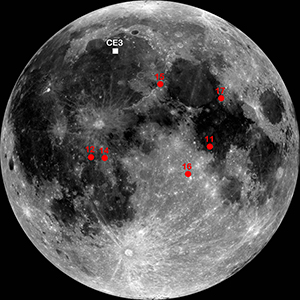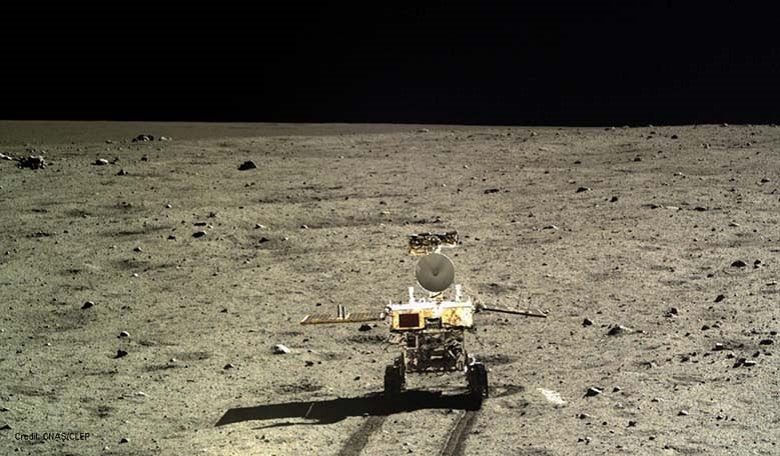Chang’e-3, the Chinese unmanned lunar mission that landed on the northern part of the Imbrue basin in 2013, has analysed samples from a prominent lava-filled impact basin visible from Earth, to reveal that the basalts at the landing site are unlike those returned by the Apollo and Luna sample return missions.
Since the termination of these two prominent lunar missions over nearly 40 years ago, exploration of the moon's surface has mainly been conducted from orbit. However, by using this method, it is only the ground-up surface layer of fragmented rock that blankets the moon – the regolith – that is primarily detected, material that is typically mixed and difficult to interpret.
In order to understand more about the moon’s make-up, Chang’e-3 touched down on a smooth flood basalt plain, next to the Zi Wei crater, a fresh impact crater that had conveniently excavated material from below the regolith. This site was chosen as the comparatively young lava flow means that the regolith layer was thin and not mixed with debris from elsewhere, thus closely resembling the composition of the underlying volcanic bedrock.
"We now have 'ground truth' for our remote sensing, a well-characterized sample in a key location," said Bradley L. Jolliff, the Scott Rudolph Professor of Earth and Planetary Sciences at Washington University in St. Louis, who is a participant in an educational collaboration that helped analyse Chang'e-3 mission data. "We see the same signal from orbit in other places, so we now know that those other places probably have similar basalts."
A chief mineral constituent of the basalts returned from both the Apollo and Luna missions is titanium. The rocks returned via these two missions were sampled from a period of peak volcanism that occurred between 3 and 4 billion years ago and contained either a high or low to very low titanium content. No samples with intermediate values were found. Conversely, basalts at the Chang'e-3 landing site are intermediate in titanium, as well as rich in iron, said Zongcheng Ling, associate professor in the School of Space Science and Physics at Shandong University in Weihai, and first author of the Nature paper in which these results are presented. In situ measurements of the minerals in the younger lava flows that Chang’e-3 is analysing – 3 billion years old or slightly less – are made by an alpha-particle X-ray spectrometer and a near-infrared hyperspectral imager aboard the Yutu rover.
 A mosaic made with the Lunar Reconnaissance Orbiter’s Wide Angle Camera showing Chang’e-3 landing site, indicated here with a white square. The landing sites of the Apollo missions are in red. Image Credit: NASA/GSFC/ASU
A mosaic made with the Lunar Reconnaissance Orbiter’s Wide Angle Camera showing Chang’e-3 landing site, indicated here with a white square. The landing sites of the Apollo missions are in red. Image Credit: NASA/GSFC/ASU
The concentration of titanium varies so much in concentration, from less than 1 weight percent TiO2 to over 15 percent, and is an indication of when the early magma oceans first solidified. Titanium, like other minerals found in basaltic magma, crystallise as the magma cools and they do so in a certain order. The first to crystallise are olivine and pyroxene, magnesium- and iron-rich minerals that are both a little denser than the magma. Plagioclase feldspar is next to crystallise but this is less dense and floats to the surface of the magma, rather than sinking like the former two minerals. Titanium on the other hand typically doesn't crystallise until perhaps only 5 percent of the original melt remains I.e. at a very late stage in the cooling process. When it finally does crystallise, it ends up in a mineral called ilmenite (FeTiO3) that is also dense, and will form areas of titanium enrichment as it sinks into the mantle.
This process of separation by crystallisation, termed fractional crystallisation, changes the composition of the magma, hence knowledge of the crystallisation sequence is critical in understanding how melt compositions evolve and how for example, the Moon's mantle and crust formed as the magma ocean cooled and solidified. Knowing the concentration of titanium however, is still posing problems for researchers, “the variable titanium distribution on the lunar surface suggests that the Moon's interior was not homogenized," says Jolliff. "We're still trying to figure out exactly how this happened. Possibly there were big impacts during the magma ocean stage that disrupted the mantle's formation."
While researchers puzzle over the moon’s interior, Yuto has helped to solve another mystery concerning olivine at Chang'e-3's landing site. Remote sensing data showed that the site was rich in olivine as well as titanium, but, as olivine usually crystallises early and the titanium-rich ilmenite crystallises late, this seems strange, adds Alian Wang, research professor in Earth and Planetary Sciences in Arts & Sciences at Washington University. Finding a rock that is rich in both doesn’t add up.
Olivine is a magnesium iron silicate, and the ratio between magnesium and iron is quite variable in different forms of the mineral. The early-forming olivine would be magnesium rich, while the olivine detected by Yutu has a composition that ranges from intermediate in iron to iron-rich. Having Yuto on hand to differentiate between the different types of Olivine has now shed light on this conundrum. “Iron-enriched olivine and ilmenite are more likely to occur together,” said Jolliff. “However, researchers still have to explain how you get to an olivine-rich and ilmenite-rich rock. One way to do that would be to mix, or hybridise, two different sources," said Jolliff. Scientists are thus suggesting that late in the magma-ocean crystallization process, iron-rich pyroxene and ilmenite, which formed late and at the crust-mantle boundary, might have begun to sink. At the same time, early-formed magnesium-rich olivine may have begun to rise and the two minerals might have mixed and hybridised. "Given these data, that is our interpretation," said Jolliff.
Whatever the outcome may turn out to be after further analysis, it is clear that these newly characterised basalts reveal a more diverse Moon than previously thought from studies following the Apollo and Luna missions and one that might still have surprises in store as even younger and even more diverse basalts on the Moon await further investigation.











